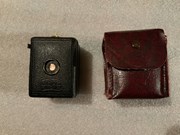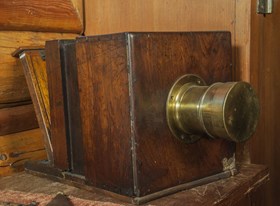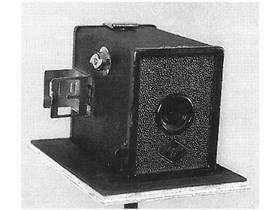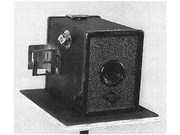Narrow Results By
- Date
- 1905 – 1920
- Material
- skin; metal; glass; plastic
- Catalogue Number
- 104.41.0003 a,b
- Description
- A small camera (a) and case (b).a) A small rectangular black leather Zeiss Ikon box camera. The camera has a round brass framed lens (“Goerz Frontar D.R.P.”), in the middle of the front side, with a hinged black metal viewfinder at the top. There is a small metal shutter arm on the right side at …
1 image
- Title
- Box Camera
- Date
- 1905 – 1920
- Material
- skin; metal; glass; plastic
- Dimensions
- 6.0 x 8.5 x 7.3 cm
- Description
- A small camera (a) and case (b).a) A small rectangular black leather Zeiss Ikon box camera. The camera has a round brass framed lens (“Goerz Frontar D.R.P.”), in the middle of the front side, with a hinged black metal viewfinder at the top. There is a small metal shutter arm on the right side at the bottom and a key to wind film at the top. Two round red plastic windows on the back allow the user to check the advance of the film. The bottom and left side of the camera have small threaded holes (for attachment to a tripod?), and the right side has a small ring to pull the latch from the button and lift off the front of the camera. A wire frame is pulled at the top to unlock the shutter and a small metal tab at the top left side pulls out for timed exposure. The camera is marked “Zeiss Ikon Film A8 4X6 1/2cm 1 5/8X2 1/2in”. b) The cameral has a closely fitted dark red textured vinyl case with a snapping flap top.
- Credit
- Gift of Pearl Evelyn Moore, Banff, 1979
- Catalogue Number
- 104.41.0003 a,b
Images
This material is presented as originally created; it may contain outdated cultural descriptions and
potentially offensive content.
Read more.
- Date
- 1840 – 1850
- Material
- wood; glass; metal
- Catalogue Number
- 104.41.0005 a,b
- Description
- (a) Large dark brown wooden box camera which is constructed so that back half of camera slides into front half to focus and is secured in place by means of a brass thumbscrew into a slot in the base. Large brass lens screwed over aperture hole at centre of front side of wooden box, square glass pla…
1 image
- Title
- Box Camera
- Date
- 1840 – 1850
- Material
- wood; glass; metal
- Dimensions
- 25.2 x 24.0 x 42.3 cm
- Description
- (a) Large dark brown wooden box camera which is constructed so that back half of camera slides into front half to focus and is secured in place by means of a brass thumbscrew into a slot in the base. Large brass lens screwed over aperture hole at centre of front side of wooden box, square glass plate set into wooden frame slides into slot at back of camera. (b) a separate plateholder of the same size has hinged door on back of frame which opens to insert black metal film sheath (Eastman Kodak), and front of frame slides out by pulling on metal ring at top to expose film. Note: wood cracking and separated at joints, chipped at lower front corners with large chunk of wood out of lower right, plateholder cracked across door and on one side of top.
- Subject
- households
- hobbies
- photography
- J.D. Curren
- PW
- Credit
- Gift of Catharine Robb Whyte, O. C., Banff, 1979
- Catalogue Number
- 104.41.0005 a,b
Images
This material is presented as originally created; it may contain outdated cultural descriptions and
potentially offensive content.
Read more.
- Date
- 1938
- Material
- metal; glass; paper
- Catalogue Number
- 104.41.1113 a,b
- Description
- A simple black box camera with black, simulated textured leather. It also has an adhesive-taped, original box. The inverted aperture in the front has a black metal retention ring surrounding it. Below this “Agfa” is imprinted on the camera, surrounded by a diamond-shaped box. There is a black metal…
1 image
- Title
- Box Camera
- Date
- 1938
- Material
- metal; glass; paper
- Dimensions
- 8.5 x 6.5 cm
- Description
- A simple black box camera with black, simulated textured leather. It also has an adhesive-taped, original box. The inverted aperture in the front has a black metal retention ring surrounding it. Below this “Agfa” is imprinted on the camera, surrounded by a diamond-shaped box. There is a black metal rim which overlaps the edges on the front of the camera; on both sides there is a slight extension, .03 x.05 wide, 2.0cm from the top, with a hole in the metal. This fits over two small metal knobs on each side of the camera body. It appears that pushing the knobs in and pulling, would release the front part of the camera from the body. On the viewer’s left is the metal shutter release; a small metal lever that can be pulled down to release the shutter and expose the lens from inside the body. On the same side is the metal film winder, 3.0cm from the front and .50cm from the top; this is a flat piece of metal 2.0cm in diameter, with arrows indicating the direction to turn (clockwise arrows), a round raised metal tab, onto which is screwed a piece of metal (2.5cmx1.0cm wide in the middle) to wind the film. It can also be pulled out to release the metal film chamber. The metal is turned down on the side of each end so the fingers can grasp it for turning. A metal folding viewfinder is .50cm from the back and 2.7cm from top and bottom; a flat piece of metal 3.0cm sq., folded at the sides, is rivetted onto the body. Two flat metal pieces are attached at each end, one on a spring to fold down; this piece is 2.4x2.7cm wide with a window cut out .50x1.0cm wide. The other piece is 2.7cm sq. with a window of 1.5x2.4cm wide; the cutout has a piece of metal raised from the bottom of the window. The cutout is for perspective when you look through the viewfinder, vertically or horizontally. This piece of metal folds down to become the top, effectively making the viewfinder flat when not in use. There is a hinged door on the back of the camera and a cut-out metal latch on the door that connects to a small metal knob 1.0cm from the edge of the body. There is a red circle film window (1.0cm diagonally) which lets you read the frame number on the film. On the inside of the door are two rivets that connect the hinge. Above that and below the red circle, is a white painted circle with “USE AB” printed in black, overlapping a painted orange, blue, white, and yellow Agfa Plenachrome film box. The red viewfinder is 4.0cm from the base. A metal film chamber, with two metal rollers on each end for winding the film on, fits inside the camera. It can be released by pulling out the film winder. The canister is 7.0x5.0 wide, is open at one end, hollow in the centre, sloping upwards with a circular hole at the other end to let light in. There are two sprockets sitting on two cutouts on top of the canister and two on the bottom, onto which the film is winded. There are two rivets attaching two Y-shaped metal pieces, on either end that guide and let the film move and roll. The top of the camera has two metal knobs 1.5cm crosswise from each end, where a leather strap with a hole on either end, .07cm from the edge, fits in to make a diagonal strap/handle for carrying. The strap is imprinted with “A-8 CADET”. There is a small metal pull-up tab, 1.0cm from the edge of the front of the camera, that lets you time the shutter speed.
- Subject
- households
- photography
- hobbies
- Bob Louden
- Credit
- Gift of Bob Louden, Calgary, 2004
- Catalogue Number
- 104.41.1113 a,b
Images
This material is presented as originally created; it may contain outdated cultural descriptions and
potentially offensive content.
Read more.






